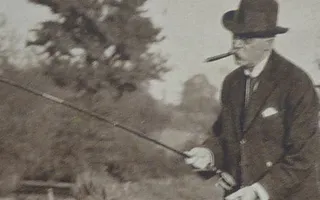To attempt to understand the importance of angling hero Robert Bright Marston we must step back to the late Victorian era. Leave behind your tablet, mobile phone and every other gadget you just can't live without.
Marston served as president of the Anglers' Benevolent Society for more than 20 years, thus supporting many old timers who had fallen on hard times. He held the post of honorary vice president of the LAA and appeared in the LAA honours list for those who "have rendered signal service to the Angling Interests, and to the Association generally". For his services, Marston received full life membership.
On behalf of the LAA he managed the London-based Fishing Gazette Fly and Bait Casting Tournaments held at the Welsh Harp in Brent. Sadly, angling is no longer permitted on this venue.
Protecting fish and fishing
Along with Anglers News editor AR Matthews and Hugh Sheringham of The Field, Marston actively campaigned for the setting up of an Anglers' Defence Fund to combat legislation changes contained in the 1911 Protection of Animals Act, whereby the use of worms and maggots as anglers' baits could have been banned by law. Marston, along with Philip Geen, Jim Bazley and Alf Waterhouse, also played a key role in the formation of the 1923 Salmon and Freshwater Fisheries Act, still the cornerstone of fish and fishery protection today.
Marston the author
Marston had a wealth of knowledge on angling books and fishery-related texts, adding much to the angler's library. In 1901 he compiled the supplement to Westwood and Satchell's 1883 'Bibliotheca Piscatoria', a catalogue of all books written on or associated with angling. He went on to write 'Walton and Some Earlier Writers on Fish and Fishing' plus editing the very famous 1905 Lea and Dove edition of Izaak Walton's 'Compleat Angler'.
In addition, Robert wrote two small pamphlets for the 1893 International Fisheries Exhibition, 'Coarse Fish Culture' and the 'Cultivation of Freshwater fish'. Marston also spearheaded the campaign for the Walton memorial window in Winchester Cathedral. This was finally achieved in 1914 and the Fisherman's Chapel remains a place of pilgrimage for anglers from all over the world.
Pollution fighter and top class angler
On the anti-pollution front, Marston fought for restrictions on road tar that continually found its way into watercourses in times of heavy rain. Marston was awarded a silver medal and diploma at the 1880 Berlin International Fisheries Exhibition for services to angling and literature.
He chaired the Thames Angling Preservation Society (established at Hampton 1838) linking up with angling notaries such as Frank Buckland and Francis Francis. A founder member of the Fly Fishers Club, he held the post of president in 1897 and 1910. A frequent companion of the legendary pike angler Alfred Jardine, Marston's best pike topped 26lb. He was a great fly fisherman and took trout to 8lbs and grayling over 2lbs.
Fishing tackle inventor
Being a great and practical angler, Marston designed a number of gadgets and aids for the angling community. Around the turn of the 20th century, Marston designed the bulbous Fishing Gazette pike float, sporting a bright red or yellow top with a gold Allcocks label, synonymous with pike fishing throughout the 20th century.
Marston is credited with being the originator of the barbed shank hook for securing baits like worm back in 1884. In addition, Marston took out a patent for revolutionary celluloid 'artificial' flies.
With salmon anglers in mind, another useful Marston design saw the birth of the Fishing Gazette winch, where the flanges of the wooden spool were made slightly concave to allow braking with thumb or finger pressure. A later variant was the ebonite and aluminium 'Marston Crossle' retailed by the giant tackle firm Millwards of Redditch.
Legacy
Robert's legacy lived on with his sons, Edward and Robert, who later edited the Fishing Gazette, and of course his granddaughter, Pat Marston, who married the legendary Dick Walker.
As Nelson Bromley wrote of Marston:
"True to his convictions, true to his friends, and true to himself, he fought his way through many campaigns so often undertaken for the preservation of fish."








